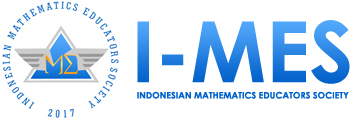Designing Learning Trajectory for Teaching Fractions Using PMRI Approach with a Chessboard Context
DOI:
https://doi.org/10.35706/sjme.v6i2.5866Abstract
The concepts of fractions and their operations is one of the materials that elementary school students need to master it. This research aims to produce student’s learning trajectory in understanding the concept of fractions. The approach used is Pendidikan Matematika Realistik Indonesia (PMRI) Approach and the media used is a chessboard. The use of the chessboard context is the initial activity in learning and followed with several questions related to the context used. The research method used is design research with type of validation studies. The research subjects in this study were three students in fourth grade of Madrasah Ibtidaiyah (MI) Al Munawwarah Jambi City. This research produces a learning trajectory (LT) which contains a series of learning processes that assist students to understand the concept of fractions. Based on the results of the research, it was found that the learning trajectory using a chessboard context could assist students to understand the concepts of fractions well.
Keywords: Learning Trajectory, Fractions, PMRI, Chessboard
Downloads
References
Akker, J.V.D., Gravemeijer, K., McKenney, S., Nieveen, N. (2006). Educational Design Research. London: Routledge Taylor & Francis Group.
Ananda, R. (2018). Penerapan Pendekatan Realistic Mathematics Education (RME) untuk Meningkatkan Hasil Belajar Matematika Siswa Sekolah Dasar. Jurnal Pendidikan Matematika (Cendikia): Vol.2, No.1, pp.125-133.
Andani, M., Pranata, O.H., Hamdu, G. (2021). Systematic Literature Review: Model Problem Based Learning pada Pembelajaran Matematika Sekolah Dasar. Jurnal Ilmiah Pendidikan Guru Sekolah Dasar (PEDADIDAKTIKA): Vol.8, No.2, pp.404-417.
Andriani, M.R., Wahyudi. (2016). Pengembangan Media Pembelajaran Power Point Interaktif Melalui Pendekatan Saintifik untuk Pembelajaran Tematik Integratif Siswa Kelas 2 SDN Bergas Kidul 03 Kabupaten Semarang. Jurnal Pendidikan dan Kebudayaan (Scholaria), 6(1), 143-157.
Bakker, A. (2004). Design Research in Statistics Education. On Symbolizing and Computer Tools. Utrecht, The Netherland: CD Beta Press.
Cobb, P., Confrey, J., Disessa, A., Lehrer, R., Schauble, L. (2003). Design Experiments in Educational Research. Educational Research. 32(1).9-13.
Dahlia, A., Pranata, O.H., Suryana, Y. (2020). Pengaruh Interactive Learning terhadap Minat Belajar Siswa pada Penjumlahan Operasi Hitung Bilangan Bulat. Jurnal Ilmiah Pendidikan Guru Sekolah Dasar (PEDADIDAKTIKA). 7(4), 32–41.
Firdaus, A. 2018. Pendekatan Matematika Realistik dengan Bantuan Puzzle Pecahan untuk Siswa Sekolah Dasar. Jurnal Pendidikan dan Kebudayaan (Scholaria): Vol.8, No.3, 243-252.
Febriyanto, B., Haryanti, Y.D., Komalasari, O. (2018). Peningkatan Pemahaman Konsep Matematis Melalui Penggunaan Media Kantong Bergambar pada Materi Perkalian Bilangan di Kelas II Sekolah Dasar. Cakrawala Pendas, 4(2), 32–44.
Gravemeijer. (1994). Developing Realistic Mathematics Education. Utrech: Freudenthal Institue.
Gravemeijer, K., Cobb, P. (2006). Educational Design Research: Design Research from a Learning Design Perspective. UK: Routledge.
Helse, Y., Hartono, Y. (2011). Designing Reflection and Symmetry Learning by Using Math Traditional Dance in Primary School. Journal of Mathematics Education. 2(1), 79- 94.
Heuvel-Panhuizen, M.V.D. (2003). The didactical use of models in RME: An example from a longitudinal trajectory on percentage. Educational Studies in Mathematics. 54.9-35.
Kurino, Y.D. (2020). Model Problem Based Learning (PBL) pada Pelajaran Matematika di Sekolah Dasar. Jurnal Elementaria Edukasia, 3(1), 150–154.
Lidinilah, D., Apriliya, S., Mulyasari, D., Andriani, E., Pratiwi, V. (2015). Buku Bacaan Anak Berbasis Karakter sebagai Sumber Belajar Matematikadi Sekolah Dasar. Prosiding Seminar Nasional Matematika dan Pendidikan Matematika UMS, 280–293.
Plomp, T. (2013). Educational Design Research: An Introduction. In T. Plomp & N.Nieveen (Eds), Educational Design Research-Part A: An Introduction. Enschede: Netherlands Institute for Curriculum Development.
Putri, R.I.I. (2013). Pengembangan Soal Tipe PISA Siswa Sekolah Menengah Pertama dan Implementasinya Pada Konteks Literasi Matematika (KLM) 2011. Prosiding Seminar Nasional Matematika dan Terapan. 28- 29 November. Aceh, Indonesia.
Reeves, T.C., Herrington, J., Oliver, R. (2004). A Development research agenda for online collaborative learning. Etr&D-Educational Technology Research and Development, 52(4). 53-65.
Sembiring, R.K., Hadi, S., & Dolk, M. (2008). Reforming Mathematics Learning in Indonesian Classrooms Through RME. ZDM Mathematics Education, 40, 927-939.
Sembiring, R.K. (2010). Pendidikan Matematika Realistik Indonesia (PMRI): Perkembangan dan Tantangannya. Journal on Mathematics Education, 1(1), 11-16. https://doi.org/10.22342/jme.1.1.791.11-16
Wijaya. A., Elamini., Doorman, M. (2021). A Learning Trajectory for Probability: A Case of Game-Based Learning. Journal on Mathematics Education. 12(1). 1-16. https://doi.org/10.22342/jme.12.1.12836.1-16
Zulkardi, & Putri, R.I.I. (2010). Pengembangan Blog Support untuk Membantu Siswa dan Guru Matematika Indonesia Belajar Pendidikan Matematika Realistik Indonesia. Jurnal Inovasi Perekayasa Pendidikan (JIPP). 2(1), 1 – 24.
Zulkardi, & Putri, R.I.I. (2019). New School Mathematics Curricula, PISA and PMRI in Indonesia. In: Vistro-Yu, C.P., & Toh, T.L. (eds.). School Mathematics Curricula, Mathematics Education – An Asian Perspective. Singapore: Springer.
Downloads
Published
How to Cite
Issue
Section
License

This work is licensed under a Creative Commons Attribution-ShareAlike 4.0 International License.
Authors who publish with this journal agree to the following terms:
- Authors retain copyright and grant the journal right of first publication with the work simultaneously licensed under a Creative Commons Attribution License that allows others to share the work with an acknowledgment of the work's authorship and initial publication in this journal.
- Authors are able to enter into separate, additional contractual arrangements for the non-exclusive distribution of the journal's published version of the work (e.g., post it to an institutional repository or publish it in a book), with an acknowledgment of its initial publication in this journal.
- Authors are permitted and encouraged to post their work online (e.g., in institutional repositories or on their website) prior to and during the submission process, as it can lead to productive exchanges, as well as earlier and greater citation of published work (See The Effect of Open Access).












